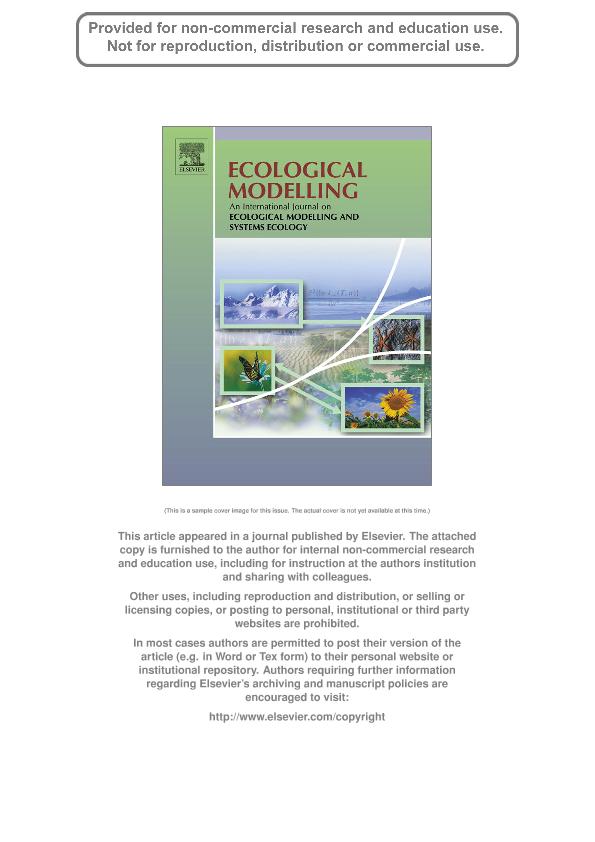Mostrar el registro sencillo del ítem
dc.contributor.author
Romeo Aznar, Victoria Teresa

dc.contributor.author
Otero, Marcelo Javier

dc.contributor.author
de Majo, María Sol

dc.contributor.author
Fischer, Sylvia Cristina

dc.contributor.author
Solari, Hernan Gustavo

dc.date.available
2015-10-02T20:13:18Z
dc.date.issued
2013-03-24
dc.identifier.citation
Romeo Aznar, Victoria Teresa; Otero, Marcelo Javier; de Majo, María Sol; Fischer, Sylvia Cristina; Solari, Hernan Gustavo; Modeling the complex hatching and development of Aedes aegypti in temperate climates; Elsevier Science; Ecological Modelling; 253; 24-3-2013; 44-55
dc.identifier.issn
0304-3800
dc.identifier.uri
http://hdl.handle.net/11336/2294
dc.description.abstract
Here, we present and discuss a compartmental stochastic model for Aedes aegypti conceived as a mathematical structure able to interpolate and extrapolate (predict) biological phenomena, and direct the attention to biological matters that need experimental elucidation. The model incorporates weather information in the form of daily temperatures and rain and pays particular attention to determining factors in temperate climates. Sufficiently large rains trigger egg hatching, which in turn leads to peaks in larval densities. Hatching is inhibited by the absence of bacteria (Gillett effect), a mechanism of relevance during the winter season and in seasons with isolated rains. The model also incorporates egg hatching independent of rains. Both egg hatching and larval development depend on the availability of food, which is modeled as bacteria produced at rates that depend on the temperature. Larval mortality and pupation rates depend on the larvae to bacteria ratio. The results of the model for egg laying activity were compared with field records during a normal season and a drought. Both the model and the records indicate that the egg laying activity of Ae. aegypti is not zero during the drought and recovers quickly when normal weather is reestablished. We studied the sensitivity of the model to different sets of physiological parameters published for a few different local populations of this species, and found that there is an important sensitivity to local characteristics that will affect some predictions of the model. We emphasize that if the information is going to be used to evaluate control methods, the life cycle of the mosquito must be studied for the local strain under the local environmental conditions (including food). We showed that the adult populations produced by the model are insensitive to certain combinations of parameters and that this insensitivity is related to the variability reported for different strains obtained from closely located places. When the model is considered in a larger biological context, it indicates that some standard procedures performed to measure the life cycle of Ae. aegypti in the laboratory might have a determining influence in the results.
dc.format
application/pdf
dc.language.iso
eng
dc.publisher
Elsevier Science

dc.rights
info:eu-repo/semantics/openAccess
dc.rights.uri
https://creativecommons.org/licenses/by-nc-nd/2.5/ar/
dc.subject
BACTERIA
dc.subject
FOOD
dc.subject
LOCAL STRAINS
dc.subject
RAIN
dc.subject
STOCHASTIC MODEL
dc.subject
TEMPERATURE
dc.subject.classification
Matemática Aplicada

dc.subject.classification
Matemáticas

dc.subject.classification
CIENCIAS NATURALES Y EXACTAS

dc.subject.classification
Zoología, Ornitología, Entomología, Etología

dc.subject.classification
Ciencias Biológicas

dc.subject.classification
CIENCIAS NATURALES Y EXACTAS

dc.title
Modeling the complex hatching and development of Aedes aegypti in temperate climates
dc.type
info:eu-repo/semantics/article
dc.type
info:ar-repo/semantics/artículo
dc.type
info:eu-repo/semantics/publishedVersion
dc.date.updated
2016-03-30 10:35:44.97925-03
dc.journal.volume
253
dc.journal.pagination
44-55
dc.journal.pais
Países Bajos

dc.journal.ciudad
Amsterdam
dc.description.fil
Fil: Romeo Aznar, Victoria Teresa. Universidad de Buenos Aires. Facultad de Ciencias Exactas y Naturales. Departamento de Física; Argentina. Consejo Nacional de Investigaciones Científicas y Técnicas. Oficina de Coordinación Administrativa Ciudad Universitaria. Instituto de Física de Buenos Aires; Argentina
dc.description.fil
Fil: Otero, Marcelo Javier. Consejo Nacional de Investigaciones Científicas y Técnicas. Oficina de Coordinación Administrativa Ciudad Universitaria. Instituto de Física de Buenos Aires; Argentina. Universidad de Buenos Aires. Facultad de Ciencias Exactas y Naturales. Departamento de Física; Argentina
dc.description.fil
Fil: de Majo, María Sol. Consejo Nacional de Investigaciones Científicas y Técnicas. Oficina de Coordinación Administrativa Ciudad Universitaria. Instituto de Ecología, Genética y Evolución de Buenos Aires; Argentina. Universidad de Buenos Aires. Facultad de Ciencias Exactas y Naturales. Departamento de Ecología, Genética y Evolución; Argentina
dc.description.fil
Fil: Fischer, Sylvia Cristina. Universidad de Buenos Aires. Facultad de Ciencias Exactas y Naturales. Departamento de Ecología, Genética y Evolución; Argentina. Consejo Nacional de Investigaciones Científicas y Técnicas. Oficina de Coordinación Administrativa Ciudad Universitaria. Instituto de Ecología, Genética y Evolución de Buenos Aires; Argentina
dc.description.fil
Fil: Solari, Hernan Gustavo. Consejo Nacional de Investigaciones Científicas y Técnicas. Oficina de Coordinación Administrativa Ciudad Universitaria. Instituto de Física de Buenos Aires; Argentina. Universidad de Buenos Aires. Facultad de Ciencias Exactas y Naturales. Departamento de Física; Argentina
dc.journal.title
Ecological Modelling

dc.relation.alternativeid
info:eu-repo/semantics/altIdentifier/doi/http://dx.doi.org/10.1016/j.ecolmodel.2012.12.004
dc.relation.alternativeid
info:eu-repo/semantics/altIdentifier/url/http://www.sciencedirect.com/science/article/pii/S0304380012005704
Archivos asociados
